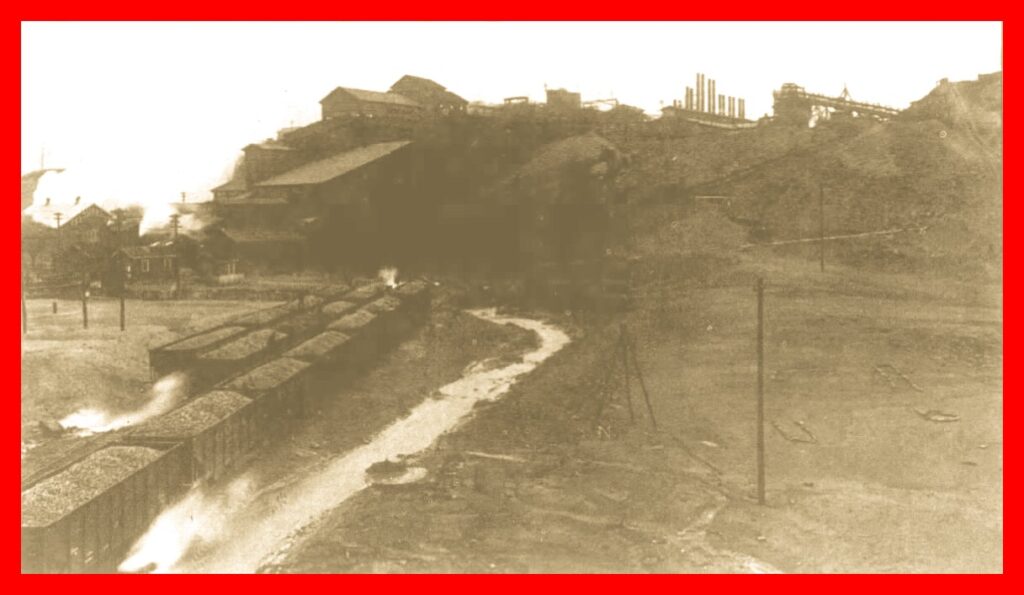Train cars filled with various sizes of coal await movement from the Shenandoah City Colliery.
From a series of articles that appeared in the Pottsville Republican and Herald in 1997:
The Shenandoah City Colliery was located at the east end of Shenandoah on Shenandoah Creek. It was the first colliery to open in the Shenandoah Basin.
The preliminary work of clearing the ground of magnificent timber and erecting 47 houses for the employees was started in 1862 and completed in 1863.
The original opening of the colliery was a drift driven eastward on the Mammoth Vein by Miller, Son and Roads in 1863. During the same year, the breaker was completed, containing 900,000 feet of lumber, all of which was cut on site.
The first shipment was made in February 1864 upon the completion of the railroad. Total shipments for the year of 1864 amounted to 55,028 tons of coal.
In 1866, the colliery was mined from five drifts, and all driven eastward. The original opening, or No. 1 Drift, was driven 1,700 feet on the Mammoth Vein and 150 feet from the mouth and tunneled to the 7-foot vein that at that time was driven 500 feet. The No. 2 Drift was driven 1,300 feet on the seven-foot vein when it was abandoned. The Nos. 3 and 4 Drifts were driven on the Buck Mountain Vein and the No. 5 Drift, probably the Lykens Valley Vein, was driven 400 feet but no breasts were opened.
In 1867 crews sank the slope 772 feet on the South Dip Mammoth Vein in a vein of coal 80 feet thick. Upon completion of the slope, Miller, Son & Roads were sold out by the sheriff. They continued operating the colliery under James Neal, trustee, and mined the slope and the No. 4 Buck Mountain Drift. The remaining four drifts were abandoned.
In 1872, the trusteeship was withdrawn and the colliery again came into Miller, Son & Roads’ possession as agents. They installed the first air compressor in the region for operating a hoisting engine at the head of an inside slope 750 feet east of the hoisting slope that was sunk 265 feet on the South Dip Mammoth Vein and was completed in 1873. Compressed air was used entirely for inside hoisting and pumping machinery.
Miller, Son & Roads continued to operated the colliery until their lease expired in 1878, when they drilled an 8-inch borehole 2245 feet to the head on an inside slope sunk 975 feet on the Top Split Mammoth Vein.
In 1888, the company began sinking the main hoisting slope to a depth of 454 feet and the shaft and inside slope were extensively mined.
In 1899, two air locomotives were put in service for hauling the coal from the Buck Mountain inside slope to the shaft landing.
In 1908, crews sank a new air shaft 432 feet deep for increasing the ventilation throughout several collieries.
In 1911, the Philadelphia & Reading Coal & Iron Company drilled a borehole from the surface to the head of the No. 2 underground Buck Mountain slope for passing the cables for an electric hoist to be installed. The slope was 351 feet in length and the project was completed in 1912.
In 1914, an electric engine and lighting system was installed both for inside and outside lighting and electric haulage was put in service inside and outside.
On September 10, 1929, fire was discovered and the colliery was sealed. The colliery was officially closed down October 28, 1932.
The total shipment of coal from the Shenandoah City Colliery up to 1928 was 10,974,296 tons.
_______________________________________________
Article by Frank Blase, Historian, Reading Anthracite Company Historical Library, Pottsville Republican & Herald, February 15-16, 1997. Obtained through Newspapers.com.
Corrections and additional information should be added as comments to this post.
